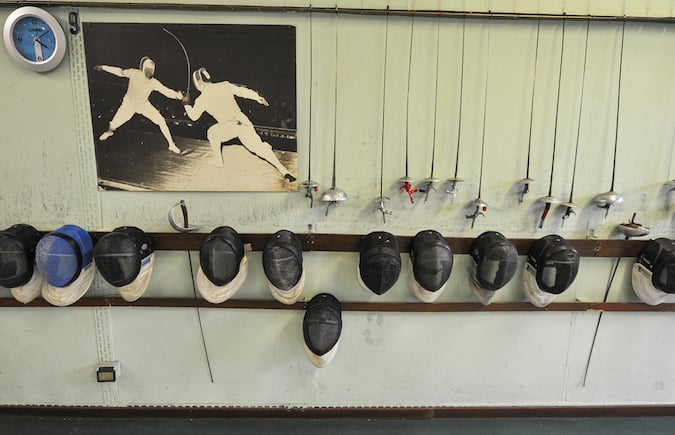Fencing competition types: Foil, Sabre, and Epee

Image credit: Shutterstock.com
There are three different weapons used in fencing, and rules vary from weapon to weapon. Here are some of the major differences in terms of fencing weapons and gameplay.
Foil
The foil is a lightweight weapon with a rectangular blade, no longer than 90 centimetres long. The maximum length of the entire weapon, including the hilt, cannot be longer than 110 centimetres. Additionally, the total maximum weight for the foil is set at 500 grams, but most fencers use lighter foils weighing around 350 grams.
The foil, also known as a thrusting or point weapon, is the most common out of three weapons used for fencing and the blades are specially designed to bend upon impact so that the risk of injuries to the opponent is lowered significantly. Fencers can only score using the tip of the blade and are required to hit specific target areas.
The target areas for foil fencing differ from epee and saber fencing, and include the torso (defined from the shoulder to groin), as well as the back of the opponent’s waist. Off-target areas include the hands, feet, head and neck. If the fencer touches an off-target area, no points will be awarded, but play will be halted.
Foil is also governed by the right-of-way rule, meaning that points are not always awarded to the fencer who hits first. Instead, the point will be awarded to the fencer who hits with priority, meaning to carry out a properly executed attack.
If the attack fails, it does not continue to hold priority. However, priority does not pass to the opponent, but instead both fencers are without priority until one party executes a proper attack.
Epee
The epee is similar to the foil, except that it has a triangular blade instead, and is slightly heavier with a maximum weight of 770 grams, although most fencers tend to use lighter epee blades. The hand guard is also larger than that in foil weapons.
Similarly, touches are only scored using the tip of the blade. However, the entire body is available as a target, including the head and limbs. Another difference in epee fencing is that fencers not only have to make a hit in the target area, but the fencer also has to ensure a minimum impact is inflicted before the score is awarded. This impact force is usually 7.4 Newtons. The right-of-way rule does not apply to epee fencing, meaning that whichever fencer executes a hit with the minimum impact required first, then the point will be awarded to that fencer.
Saber
The saber features a flat blade, and has a maximum weight of 500 grams. Unlike foil and epee fencing, the fencer is able to score points if he makes hits with any part of his blade. The target area for saber fencing includes the torso above the waist, the head and arms, but exclude the hands and anything below the opponent’s waist. Similar to foil fencing, the right-of-way rule applies.
To receive the latest updates on the happenings in the Singapore sports scene, or to find out more about some of the latest programmes on offer at ActiveSG, like our Facebook page here.





![ActiveSG Academies and Clubs Logo (Solid Colour)[8647]](https://www.activesgcircle.gov.sg/hs-fs/hubfs/ActiveSG%20Circle%202023Theme/images/ActiveSG%20Academies%20and%20Clubs%20Logo%20(Solid%20Colour)%5B8647%5D.png?width=150&height=65&name=ActiveSG%20Academies%20and%20Clubs%20Logo%20(Solid%20Colour)%5B8647%5D.png)



-01.png?width=200&height=141&name=Team%20Singapore%20Logo%20(Red)-01.png)



